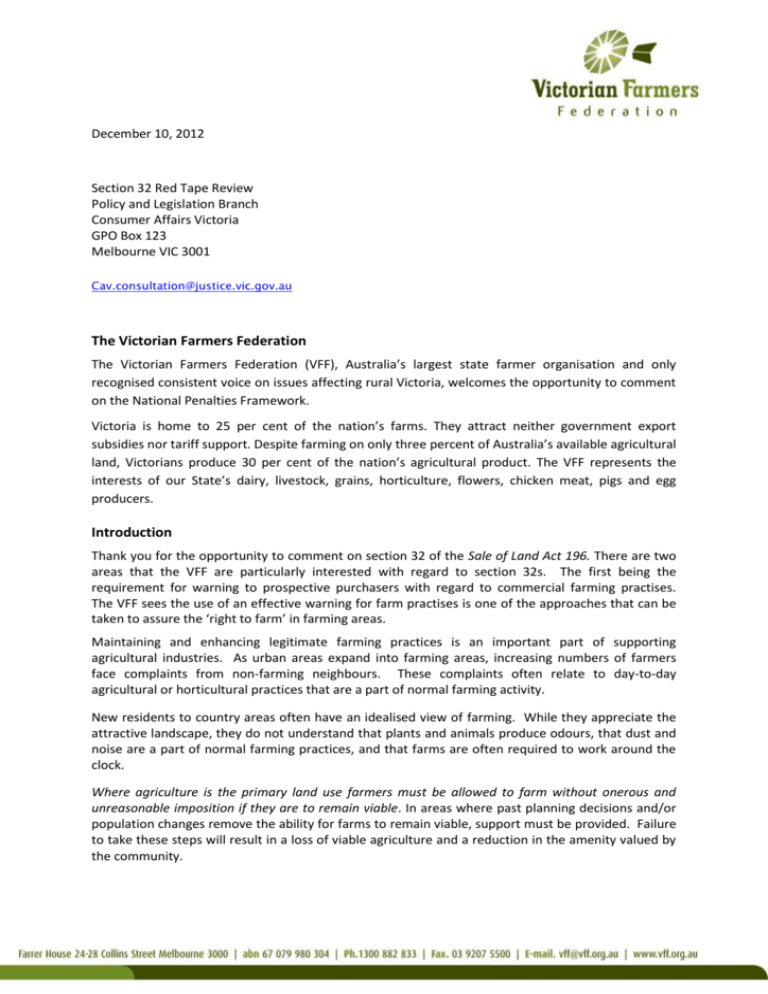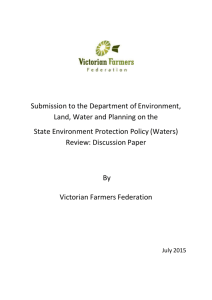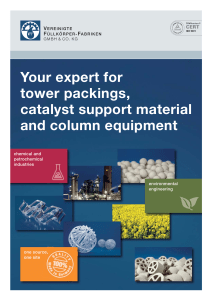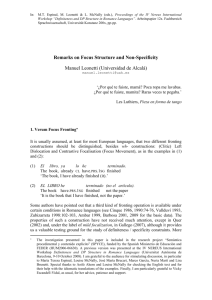Review of section 32 of the Sale of Land Act 1962 submission
advertisement

December 10, 2012 Section 32 Red Tape Review Policy and Legislation Branch Consumer Affairs Victoria GPO Box 123 Melbourne VIC 3001 Cav.consultation@justice.vic.gov.au The Victorian Farmers Federation The Victorian Farmers Federation (VFF), Australia’s largest state farmer organisation and only recognised consistent voice on issues affecting rural Victoria, welcomes the opportunity to comment on the National Penalties Framework. Victoria is home to 25 per cent of the nation’s farms. They attract neither government export subsidies nor tariff support. Despite farming on only three percent of Australia’s available agricultural land, Victorians produce 30 per cent of the nation’s agricultural product. The VFF represents the interests of our State’s dairy, livestock, grains, horticulture, flowers, chicken meat, pigs and egg producers. Introduction Thank you for the opportunity to comment on section 32 of the Sale of Land Act 196. There are two areas that the VFF are particularly interested with regard to section 32s. The first being the requirement for warning to prospective purchasers with regard to commercial farming practises. The VFF sees the use of an effective warning for farm practises is one of the approaches that can be taken to assure the ‘right to farm’ in farming areas. Maintaining and enhancing legitimate farming practices is an important part of supporting agricultural industries. As urban areas expand into farming areas, increasing numbers of farmers face complaints from non-farming neighbours. These complaints often relate to day-to-day agricultural or horticultural practices that are a part of normal farming activity. New residents to country areas often have an idealised view of farming. While they appreciate the attractive landscape, they do not understand that plants and animals produce odours, that dust and noise are a part of normal farming practices, and that farms are often required to work around the clock. Where agriculture is the primary land use farmers must be allowed to farm without onerous and unreasonable imposition if they are to remain viable. In areas where past planning decisions and/or population changes remove the ability for farms to remain viable, support must be provided. Failure to take these steps will result in a loss of viable agriculture and a reduction in the amenity valued by the community. The second issue is ensuring there is an appropriate level of disclosure provided by sellers as to the prior use of the land that may affect the future use of that land and planning overlays. For example there may have been activities conducted on that land, which may or may not be agriculture related that will affect the future uses. The unintentional contamination of land can have serious implications on future use of land and there needs to be processes in the system that protect prospective buyers from the purchase of contaminated land. It is important that not only the provisions under the Agriculture and Veterinary Chemical (Control of Use) Act provisions continue to warn against the contamination of land but also there be a requirement to disclose any other sources of contamination to the land. Commercial agricultural production activities warning Recommendation One: The Commercial agricultural activity warning continue and be strengthened to list possible specific prominent noises, smells and agricultural activities. The discussion paper notes: Under section 32(2)(cb) of the Sale of Land Act the following warning must be included in all vendor statements: ‘Important notice to purchasers: The property may be located in an area where commercial agricultural production activity may affect your enjoyment of the property. It is therefore in your interest to undertake an investigation of the possible amenity and other impacts from nearby properties and the agricultural practices and processes conducted there.’ However, the warning is generic and does not provide any specific information for a particular property about nearby agricultural practices. In addition, there is no requirement placed on potential purchasers to acknowledge that they are moving into an area with agricultural land uses. The VFF agrees with the assessment that the statement is generic and does not really assist in providing a clear understanding of the activities that may occur in the area. Unfortunately, when there are land use conflicts or concerns raised to local council often the section 32 is not referred to and there is also an obligation placed on councils to investigate complaints whether or not the complaints are justified. Questions for consultation: 1. Is this warning effective? No, the warning is not effective. Often it is glanced over and not taken into account in the purchasing decision or during the decision to follow up a vexatious complaint. 2. Do potential purchasers of agricultural land commonly undertake investigations of the nearby agricultural practices and processes when deciding whether to buy a particular property? I do not believe so. Often the reason for a move to ‘tree change’ areas is for the view, the feeling of ‘own space’ and often based on an idealistic view of country life. 3. Are there alternative options for increasing awareness in potential purchasers of agricultural land of the amenity and other impacts from commercial agriculture? The VFF that there are a raft of policy options that could be adopted to strengthen farmers ‘right to farm’ and prevent needless and vexatious complaint against farmers. The VFF believes the first step towards improving the understanding of new purchasers to land in agricultural zones comes with an improved warning under the Section 32. In our recent submission to the State government on Planning reforms, the VFF recommended “Require Section 32 statements to detail prominent noises and smells to ensure these are acknowledged prior to land being purchased.“1 This recommendation was consistent with the Coalition policy to: Require section 32 statements to detail prominent noises and smells to ensure potential owners or rural property acknowledge and accept they exist prior to purchasing. While this in itself will not fix the problem it will provide more detailed information to prospective purchasers and also provide proof, should there be noise or odour complaints that the purchaser of the land acknowledged those would occur. However the warning should not stop there. There are a number of specific warning not covered by ‘noises and smells’ that should be included. For example, there should be the acknowledgement that visual amenity can change throughout the year. During silage production large piles of silage can be left in paddocks covered by plastic tarps using tires to hold the tarp down. As this is a normal practice for the dairy industry it should not be subject to vexatious complaints. Also, the act of stock crossing access roads should have a mention in the agricultural activity warning. Stock movements across roads are very common, particularly in the dairy production areas. New owners of land adjoining roads that are used for stock crossing should acknowledge and accept this activity. In conjunction with this, the local government also needs to take this into account when dealing with complaints being place on farmers. It does need to be pointed out, that a more details account of potential noises or odours should not create the assumption that no other types of noises or odours may occur. There would still require a general warning to the nature of farming areas. The VFF would also suggest an option to consider to reduce right to farm conflicts is the British Columbia (Canada) model where there is an independent panel that deals with all ‘right to farm’ issues and if the complaint if found to be unreasonable, or the activity in question is a part of normal farming practises then the complaint is rejected. 1 Further details on VFF recommendations to strength the right to farm with regard to Statutory planning can be found in the VFF submission to planning reforms available on the VFF website. Agricultural and veterinary chemicals contamination Recommendation Two: Disclosure of land use restrictions subject to the Agricultural and Chemicals (Control of use) Act should be required. From the discussion paper: Section 32(2)(i) of the Sale of Land Act requires vendors to provide details of any current land use restriction notice given in relation to the land under the Agricultural and Veterinary Chemicals (Control of Use) Act 1992 (‘the Agricultural and Veterinary Chemicals (Control of Use) Act’) due to contamination. The Agricultural and Veterinary Chemicals (Control of Use) Act enables land use restriction notices to be issued that regulate the growing of plants or keeping of stock on land, in circumstances where it is likely the resulting plants or stock could be contaminated. Such notices may prohibit the growing of plants or keeping of stock on the land completely or permit it subject to certain conditions.3 Section 51 of the Agricultural and Veterinary Chemicals (Control of Use) Act enables details of land use restriction notices to be disclosed on application. However, this can only occur with the consent of the landowner. There are no other disclosure requirements under that Act in relation to land use restriction notices. Questions for consultation: 1. Is such specific disclosure of contaminated agricultural land still required? It is important that this disclosure remains. The VFF would support the requirement for land use restrictions based on section 51 of the Agricultural and Veterinary Chemicals (Control of Use) Act to be disclosed in section 32. There are cases in the past with the use of Dieldren and DDT has led to serious contamination of the land. The result of this contamination of the land is a reduction in the potential future use of the land. It is extremely important that potential buyers are aware of future land use restrictions. Also, It is an offense (under the EPA Act) to sell contaminated land without full disclosure and agreement between both parties (buyers and sellers) and having this disclosure as mandatory will ensure this is adhered to. 2. Are these notices easy for a potential purchaser to obtain? Unsure. 3. Could land use restriction notices form part of a general disclosure of notices affecting the land? No. If there are land use restrictions based on the Ag and Vet Chemical Act they should be named explicitly. There is a risk that if it formed a general disclosure Additional Concerns The VFF have been approached by members voicing concern with the lack of transparency around the naming of areas of aboriginal heritage sites. Anecdotally, there has been aboriginal heritage overlays placed on farmers lands, without their knowledge and therefore without the knowledge of prospective purchasers of that land. There should be proper feedback mechanisms to land holders if there is consideration of placing any overlays of property including aboriginal heritage. There is also no requirement for this overlay to be stated in a section 32 and this should be considered. Recommendation Three: Include a general warning regarding the application of overlays (including Aboriginal Heritage overlays) and where information an applicable overlays can be found. Also, recently The Public Land Consultancy newsletter ‘Terra Publica’2raised the issue of lack of disclosure relating to crown land that may appear to be part of a sale, but is actually a license that is issued by the State government and can be revoked at any time. For farmers, this is particularly important in cases regarding unused roads and riparian areas. Recommendation Four: Include mandatory disclosure of land area subject to Government license arrangements Thank you for the opportunity to comment and if you wish to discuss further please contact Darryl Harrison, Policy Manager (03 9207 5522) Kind regards, Peter Tuohey President Victorian Farmers Federation M: 0428 952 425 Email: ptuohey@vff.org.au 2 November 2012 edition










